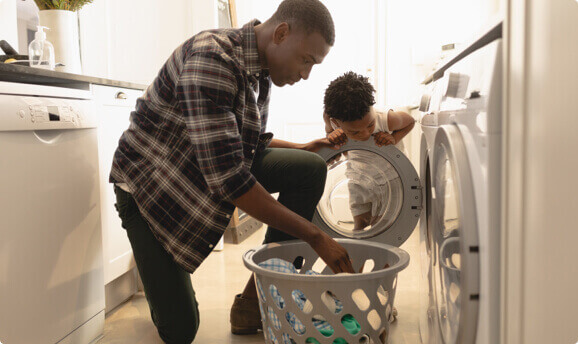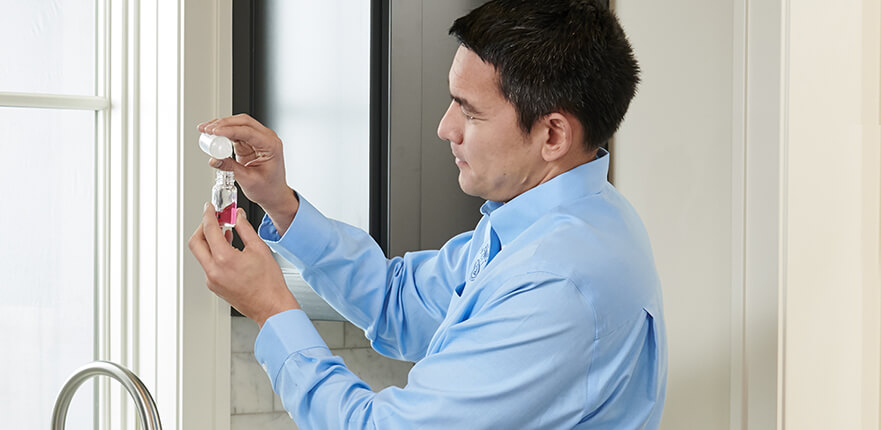Over 85% of North American households live in areas with hard water. Yet many homeowners are still unsure of the effects of hard water on a house and what consequences their family may face because of it.
To respond accordingly to a hard water problem, take a step back and understand what hard water is and where it comes from.

What Is Hard Water, and What Does Having It Mean?
Hard water contains varying amounts of dissolved minerals like calcium, lead, and magnesium — with the very real possibility of many more. Water picks up these minerals as it trickles from its source and gets transported to your supply. The hard water level and specific minerals in your water depending on where it comes from and how long it takes to get to your home. The main reason many areas have different levels of hard water is that no supply is the same.
Hard water can have annoying to downright detrimental effects on your home and family, no matter the severity. White, chalky residue on sinks and higher utility bills from appliances working overtime are just a few signs (and costly results) of hard water. Learn how to take the best care of your home and family by understanding the level of hard water in your area and its potentially costly effects on your daily life.
How Is the “Hardness” of Water Measured?
The level of hardness in water is measured in grains per gallon (gpg). One grain is equivalent to 17.1 milligrams of magnesium or calcium dissolved into one liter of water. Soft water is lower than 1 gpg, whereas hard water is anything over 7 gpg.
For example, a single aspirin is equivalent to 5 grains — when dissolved into a gallon of water, the unit of measure would be 5 grains per gallon. Your local municipal water supply may use mg/L or ppm to measure water hardness. If so, then use this calculation: 1 gpg = 17.1 mg/L or 17.1 ppm.
How Do I Find My Water Hardness Level?
You can find out how hard your water is by reviewing the annual drinking water quality report, contacting your local water municipality (if the report neglects to include a hard water rating), or by having your local EcoWater dealer provide a free water diagnosis.
How Does a Water Softener Work?
Having a water softener for hard water areas is the key to cleaner dishes, brighter clothes, lower energy bills and a healthier family. Investing in a water softener makes life easier with minimal work needed from a homeowner.
Water softeners should be installed on a water pipeline before the water heater. After having a water softener installed in your home, the system will do the work for you — simply monitor salt level every 2-3 months.
The Water Softening Process
- Once installed, hard water enters the resin tank and flows through resin beads
- Water circulates in the tank where tiny resin beads swap minerals in the water for the tiny sodium ions they’re holding
- This iron exchange results in soft water that can then enter the home
- When the resin beads have maximized their ability to hold the minerals, they need to go through a regeneration
The Regeneration Process
After the minerals have been stripped from the water, they can’t stay in the tank forever. An automated system will begin a regeneration process that will flush the minerals out of the softener and down the drain. Here’s how it works:
- Resin beads are “washed” with a highly concentrated brine solution created from the salt tank
- The brine solution forces the minerals out of the resin beads and replaces them with the sodium ions
- Once the resin beads have been recharged, the brine solution, along with the minerals, are flushed from the softener down the drain
Water softeners are now built to time the regeneration process automatically. Depending on your machine, the process will occur in one of two different ways.
Older machines: A set timer on a predetermined schedule (i.e. every 3 days at 11pm) to regenerate no matter if the resin beads actually need it or not.
Newer machines: A computerized sensor monitors bead depletion and other metrics based on water use to regenerate only when needed. These demand-initiated regeneration softeners are ideal for saving money and energy by using less water and salt.
When to Refill a Water Softener
Generally, homeowners should open the lid of their brine tank and check for a salt refill every 2-3 months. Water softeners will do the bulk of the work for you, but it’s important for you to maintain the salt levels so the machine can work properly. When a refill is needed, it’s important to purchase use high-quality salt pellets and fill your tank no more than half full to avoid salt bridging. The more you know about maintaining your water softener, the longer it will last.
Key signs a tank is in need of a refill:
- The salt appears overly wet or dry
- The tank is less than half full of salt
- Water has started to build-up
- A salt bridge has started to form
- Salt is sitting at the same level as the last checkup
What to keep in mind:
- Machine age: The older the machine, the more often you must refill because older machines are not as efficient as newer models.
- Level of hard water: The harder the water in your area, the more often you must check and refill your tank.
- Size of the tank: Naturally, the smaller the tank, the more often you will have to refill.

Have EcoWater add a water softener in your home
Contact your local EcoWater dealer for a free water diagnosis. A Water Pro will be able to determine the exact solution your home needs, so you can start enjoying the many benefits of soft water.
